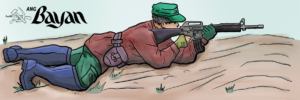Marcos is no friend to farmers Hardships under Masagana 99

In his inauguration as president last June 30, Marcos said that he will prioritize addressing the food crisis. He claimed that it was only during his father’s dictatorship that food security was given attention—as if to rub salt on the peasant masses’ unhealed wounds.
What really happened under Marcos Sr? It is relevant for the peasant masses and entire people to recall the Marcos dictatorship’s biggest sins against the peasantry. In this series, Ang Bayan aims to review the history of the peasant masses’ hardships under martial law in order to conscientiously face Marcos’ schemes that will bring greater suffering to the farmers.
Masagana 99 bankrupted farmers
In 1972, farms were crippled by pests ang disasters, causing extensive destruction and hardships to farmers. The dictator Marcos took advantage of the situation to push for the Masagana 99 program in May 1973 purportedly to raise farmers’ production. But in the process, he bankrupted the peasant masses.
Masagana 99 is Marcos Sr’s version of the “Green Revolution” scheme of the International Monetary Fund, World Bank (WB), and United States Agency for International Aid (USAID), Bayer, Monsanto and other transnational corporations in agriculture.
Its first component is the propagation of high-yielding variety (HYVs) of palay; and second, the extensive system of government-managed credit. These aimed to raise farmers’ harvest to 99 cavans of palay per hectare. HYVs are seeds produced in laboratories such as those of the International Rice Research Institute. To bear fruit, HYVs require more chemical fertilizers and pesticides—produced and sold by agrochemical transnational corporations.
From 1972 to 1982, the WB extended up to $1.5 billion in loans to fund Masagana 99. This comprised 44% of the WB’s total loans to the country. Majority went to the purchase of imported inputs (fertilizers, pesticides, food) and machine parts which in 1984 amounted to 99% of the $150 million loan.
Using HYVs caused farmers’ production expenses to swell. Between 1966 and 1979, palay production costs skyrocketed by 89%. The largest increase in expenses was in the costs of imported inputs, which grew thrice (262%) than before.
To ensure that necessary chemicals for HYVs can be bought, Masagana 99 pushed banks to provide credit for farmers. To speed up the process, loan collaterals were eliminated. The government also guaranteed up to 85% of the banks’ losses due to unpaid loans. The WB also pushed the “market” to set credit interests. From only 12%, interests on Masagana 99 loans increased by 16% to 38% in 1984.
The Marcos dictatorship bragged that “rice self-sufficiency” was achieved in 1975 and that the Philippines became a rice-exporter during 1977-1983. It does not, however, mention how these Masagana 99 “victories” caused long-term damages to the livelihood of farmers and the people in the countrysides.
Production indeed rose by 55%, but so did the farmers’ expenses which went up by 89%. This cannot compensate for the meager 20% increase in farmers’ income between 1966 and 1976. As a result, more and more farmers were unable to pay their loans. In 1979, only 45.8% were paying.
Farmers more and more lost the capacity to acquire government-managed loans. In 1980-1984, only around 60,000 farmers were included in Masagana 99, from half a million in 1974-1975. Millions of farmers went bankrupt and living standards in the countrysides plummeted. In 1983, up to 73% of the families in the countrysides were poor, compared to 33% in 1971.
By 1984, the Philippines went back to rice importation and stopped exporting rice one year later.
Moreover, the chemicals poisoned the environment and natural fertilizers were destroyed. Exposure to chemicals also caused severe health problems for farmers such as liver illnesses, diminished the rich farming culture of Filipinos, and eradicated traditional seedlings.


